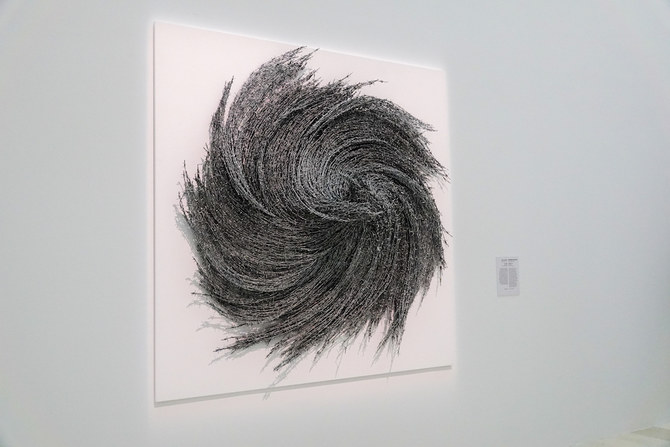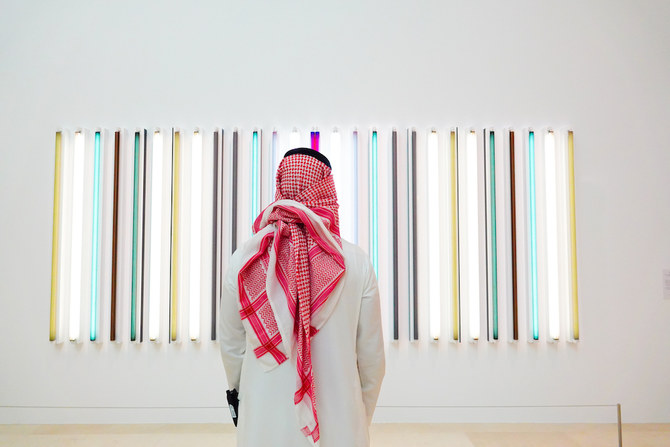The King Abdul Aziz Center for World Culture (Ithra) has launched its third art exhibition this year under the title “Seeing & Perceiving” — the first contemporary public show since the outbreak of COVID-19.
The contemporary art exhibition showcases 26 works by 20 leading names in the art scene from around the globe: 60 percent are from the Middle East, including Saudis, while 40 percent are from around the world.
Each artwork mimics the observers’ perception and encourages them to explore the meaning beyond what they can see.
“The exhibit displays art pieces from around the world; each art piece reflects a deep different meaning the more you look at it,” said Ashraf Fakeeh, head of programs at Ithra.
He added: “One of the art missions is to reinterpret life in a different way, perhaps as it speaks to your mind and soul, and the artworks here are challenging as they keep you wondering what are you looking at and how would you read it.”
Among the international installations was one by the rising Saudi artist Wala Fadul, 26, the winner of Ithra’s second Artist Open Call program, held virtually in 2020 with 158 competitive candidates.
The art installation was commissioned by Ithra, titled “Light Upon Light,” and has a sacred geometry pattern inspired by a Qur’anic verse in Surah An-Nur. It is a holographic variable of hologram fans viewed in seven colors.
In an interview with Arab News, Fadul said that her work is based on different perspectives of light and what it symbolizes for humans inspired by the imagery communication between humans and materials, and its meanings.
“In one of John Berger’s (an English critic) art books, there is a fascinating line that says ‘Seeing comes before words and it made me really wonder what comes before seeing, and the answer was the light,’” Fadul said.
She added: “There was a contradiction between me and (my) friends on the fact that light cannot be considered as an existing material. However, to me light is the base of everything. Although we cannot touch it, we realize its impact, and this is the main message that I want to deliver.”
Winning in Ithra’s Artist Open Call program in 2020 gave Fadul the chance to participate in the Seeing & Perceiving exhibition, where her artwork was adopted, financed and facilitated to come into reality.
“My artwork is installed among other local and international artworks in the exhibit of experienced artists, and this is a huge privilege for me,” she said.
Fadul is encouraging all upcoming Saudi artists to prove their art and creativity. “This is our time, we are living the change, and we are part of the journey, so we need the work and creativity will lead us to that.”
What do you see?
Three of the site-specific installations and commissioned pieces were created specifically for and at Ithra, including an eye-catching visual engagement in the escalator that leads to the center’s library by the American artist Darel Carey.
His art challenges the observer’s perception of space and optical illusion. “As far as my goal and what I want to achieve through my art, first and foremost is for people to enjoy it,” Carey told Arab News. “It is a very interactive, immersive type of experience, and also my goal is to have people think about what they see and wonder about how they perceive the way mind and eyes work.”
The contemporary exhibition prompts questions about the reality and nature of artworks. It is full of tricky, vague yet attractive artworks as every installation depends on deriving meaning through many different angles. It opens up endless horizons for understanding the artistic content.
Candida Pestana, Ithra’s contemporary art curator, told Arab News that the Seeing & Perceiving exhibition stimulated critical thinking, so everything a viewer sees perhaps will changes the second, third and last time they look at it. “We want to create the element of surprise, so they can question what they are seeing overall.”
The exhibition began on June 23 and runs until March 26. Ithra art museum receives about 100,000 visitors a year. The center is a creative and interactive public space with different programs for everyone, and it is Saudi Aramco’s most ambitious initiative and the largest cultural contribution to the Kingdom.
Highlights:
* Seeing & Perceiving showcases 26 art installations by 20 international artists.
* Some installations use realistic imagery to create the optical illusion that the depicted objects exist in three dimensions.
* The exhibition aims to make observers perceive artworks in different ways.
* The contemporary art exhibition empowers local talent.
* Ithra is showcasing 60 percent of its newly acquired art collection through the exhibition.






























